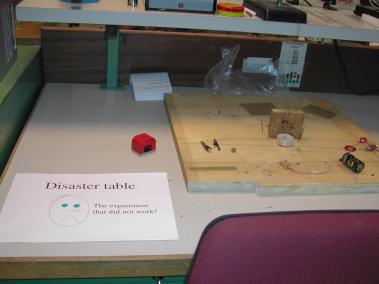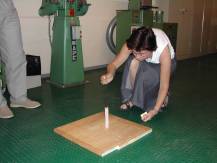 1.
Swedish rocket:
1.
Swedish rocket:
 1.
Swedish rocket:
1.
Swedish rocket:
Take
an empty teabag. Put it vertically like a chimney. Take some matches. Light up
the top of the teabag. The teabag will fly.
Physics: Convection.
2.
Singing
cymbal:
Use a cymbal or metallic plate that can vibrate freely. Use a flash, for example from a camera, hold it close to the plate and flash. You will hear a low tone.
Physics: The moment of the photons are transferred in an inelastic collision to the atoms of the cymbal. This can also be used as an example of energy conversion.
3.
Kung Fu trick
Put two wine glasses on the table. Place a wooden rod ( approx. 1cm x 1 cm x 1m) with one needle at each end on the glasses, with the needles resting on the rim of the glasses. Take a sward and hit the middle of the rod, with high velocity. The rod will break but the glasses stay intact (hopefully)
Physics: Inertia??
4.
Catching
the ball:
 Take
a strip wood (or a ladder). Nail a plastic cup on to the strip. Place a ball on
the strip, higher than the cup. Lift the wooden strip, so the ball is above the
place where the cup was (look at the picture). Let the strip fall down to the
ground. The ball will fall into the cup.
Take
a strip wood (or a ladder). Nail a plastic cup on to the strip. Place a ball on
the strip, higher than the cup. Lift the wooden strip, so the ball is above the
place where the cup was (look at the picture). Let the strip fall down to the
ground. The ball will fall into the cup.
Physics: Inertia.
5.
Falling
tower.
Take 15 to 20 wooden cubes. Build a high tower on a wooden strip. Incline the strip. The tower will fall, but not in a straight line.
Physics: The centre mass has to have an acceleration of 9,81 m/s2.
6.
The lazy magnet
Take two aluminium tubes, a magnet (with a diameter smaller than the tubes) and a piece of metal with the same dimensions as the magnet. Let the magnet and the piece of metal fall at the same time through the tubes. The magnet will come down later.
Physics: Lenz law.
7.
The thick magnet
Put a aluminium tube on a scale let a magnet (with a diameter smaller than the tube) fall through the tube. You will see that the weight increases.
Physics: Lenz law
8.
Christmas time
Put a sparkler in a drill and put the drill on. You see the sparklers forming a circle.
Physics: Central force.
9.
Balloon in prison:
Boil water. Put the water in a boiling flask and a balloon on top. Cool the water. The balloon will go in the flask. Ask the students how they can get the balloon out of the flask.
Physics: Heat the water, expansion of the gas.
10.
Jakob ladder:
Put 5000V on two copper wires, which are placed parallel and close to each other. Place a candle under the two wires. You will get a climbing spark.
Other version: Take two coat hangers and unwire them. Place them in a V-form (not touching each other) on a non-conducting block. Put 15000V on the wires again you will get a climbing spark.
Physics: convection, sparkjump.
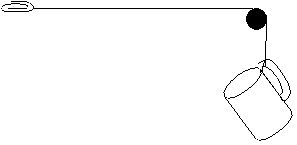 11.
The circling
paper-clip.
11.
The circling
paper-clip.
Put a cup at one end of a two meter long thread and attach a paper-clip at the other end.. Put a pencil under the thread near the cup. Let the paper clip go. It will turn around the pen, getting faster and faster.
Physics: central force, moments of inertia
12.
The loudspeaker door:
Turn a music box on. Put it on the door. The sound will increase.
Physics: Resonance.
13.
Making
music:
Take a straw and a pair of scissors. Cut of the straw while blowing in it. You will hear different tones.
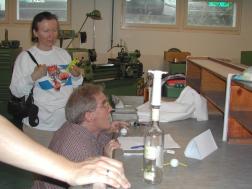 Physics:
tones.
Physics:
tones.
14.
Jumping ping pong ball:
Take two wine glasses and place them close together. Put a ping-pong ball in one of the glasses. Blow over the glass where the ball is in. The ping-pong ball will “fly” into the other glass.
Physics: Bernoulli
15.
Disappearing liquid:
Take 50 ml of ethanol and 50 ml of water. Put them together and you will have less than 100 ml. Approximately you’ll have 98%.
Model: Take 150 ml yellow peas and 150 ml rice. Put them together, you’ll have less than 300 ml.
Physics: Model
16
Flying
plastic cups:
Glue the bottoms of two plastic cups together. Take a long (0.5 m) rubber band. Wind the rubber band around the middle of the two cups. Pull the rubber band and shoot.
Physics: Moving objects
17.
The noisy pillow
Put a buzzer in a pillow. Throw the pillow around. You will hear the noise changing.
Physics: Doppler effect
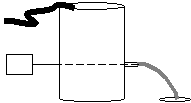 18.
The laser-trapped beam
18.
The laser-trapped beam
Take an empty plastic bottle of water (1,5 litter). Make a little hole in the middle of the bottle. Put the bottle under a tab so that the water can fall in it. Place the laser in front of the bottle so that the laser beam is trapped in the water stream.
Physics: Reflex ion
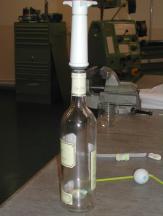 19.
Growing marsh mallows.
19.
Growing marsh mallows.
Take an empty wine bottle and put a marsh mellow in the bottle. Take a vacuum pump (the one they use for wine bottle is good). While pumping the air you will see the marsh mellows growing. Instead of marsh mellows you can use shave cream
Physics: gas laws.
20.
The magic skipping rope
Take long copper wire. Put the ends of the rope into the input of the oscilloscope. Two students have to take up the rode and the third student has to skip while the two other turns the rope.
Physics: electromagnetic induction.
21.
Dinnertime:
Put a glass, a bottle and a plate on a tablecloth. Take rapidly the tablecloth away. The glass, the bottle and the plate will not move.
Physics: inertia
22.
Catching the coin
Take a glass, put a piece of carton on top of it. In the middle of the carton you put a coin. With one finger tick you push the piece of carton of the glass. The coin will fall in the glass.
Physics: Inertia
23.
The cached water
Take a glass and fill full of water, so that the water flow over the border. Put a piece of carton on top of the glass. Turn the glass. The water will stay in the glass.
Physics: atmospheric pressure.
24.
Cola experiment
Take a bottle of coca cola light and of coca cola (normal). Fill a basket with water. Put the two coca cola bottles in the basket. The bottle with coca cola (normal) will sink and the bottle with coca cola light will float.
Physics: density
25.
Strong eggs
Take two boxes of six eggs. Open the boxes and go standing on the eggs. But support you by leaning on two chairs.
Physics: pressure
26. Monorail
Build a kind of monorail and hang it on the ceiling. Build a train that hangs on this rail and eventually power it with a battery and a small e-motor.
Physics: forces, torque, speed, distances and
time
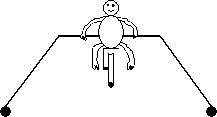 27.
Monkey Ride
27.
Monkey Ride
Like the monorail (26), but now don't build the whole monorail but just 1 meter of it. And then put a monocycle with very low point of gravity on it. And just for fun and the better looks: let a little monkey ride on it.
Physics: forces, center point of mass, torque
28.
The singing head
Take a tuning fork and after striking it you put the bottom of the fork to an ear of a student. The bones and chambers of his head will resonate and will amplify the sound.
Other version: You can do the same using a window, were you can demonstrate that more energy is lost and the sound is deadening more quickly.
Physics: sound
29.
Magnet competition
Give the pupils different kind of metal wires (1 meter long) and some different kind of screws and a battery (4,5 V). Let the pupils make the best kind of magnet they can.
They will then understand how an electromagnet works.
Pick up small sewing needles and see how many the pupils can pick up with their magnet.
Physics: magnetism
30. Barbapapa (or Barbapappa in Swedish)
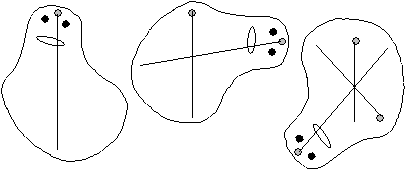 Take
a piece of thin wood or cardboard and cut an arbitrary shape out of it. Make at
least three holes in it, and hang the shape at each of the points. When the
shape is at rest draw a vertical line from the hanging-point. Repeat this for
every hole. The cross point of all the lines will be the center of mass for this
Barbapapa.
Take
a piece of thin wood or cardboard and cut an arbitrary shape out of it. Make at
least three holes in it, and hang the shape at each of the points. When the
shape is at rest draw a vertical line from the hanging-point. Repeat this for
every hole. The cross point of all the lines will be the center of mass for this
Barbapapa.
Physics: center of mass, (torque)
31. The Monkey Gun
Tilt a smooth table by a few centimeters. Use
two marbles or steel balls. One is simply released from one top corner to roll
down the table. The challenge for the students is to figure out how to release
the other marble from the other top corner so that it strikes the first one
before it reaches the bottom. They have to find a way that will let them strike
the marble every time. (Obviously, they need to shoot it horizontally at the
same moment that they release the first marble. The easiest way to do it is to
lay a meter stick across the top of the table, set one marble, and start the
other one rolling along the meter stick. Then lift the meter stick.)
Physics: To show that vertical acceleration is not affected by horizontal
velocity
32. Showing Moment of Inertia
Equipment: Two cans of some very solid food like
tomato paste or puree, one of them as is, the other is emptied with both ends of
the can removed. Also take two small balls of about the same diameter as the
cans, one hollow and one solid. I find a ping pong ball is excellent for the
hollow ball. Tilt a smooth table by one or two inches and put a cardboard box on
a chair to catch the things as they roll off at the bottom. Line the cans and
balls up across the top end, using a meter stick to hold them steady. Challenge
the students to predict whether they will all roll down together, or if not,
then which one will win the race down the table, which will be second, etc. Lift
the meter stick.
Physics: To show that moments of inertia for rings, solid cylinders, hollow
spheres, and solid balls are different
33. Estimating the value of the Moment of Inertia
This follows the previous experiment. It depends on being able to set up
a low friction sliding track. An Air Track or a small rolling cart is possible.
What I like best is to use water on a table and slide an ice cube. This time,
one of the rolling masses races the sliding mass. You can get quite a good value
for moment of inertia by comparing how much the rolling mass is delayed relative
to the sliding mass. I have tried this with two equal size cans of food, one
with solid food, and the other with liquid food. It should work, because the
liquid will mostly slide down the table, but I have never been able to make this
work.
Physics: To get an estimate of the value of the moment of inertia
 34.
Dancing ball
34.
Dancing ball
Take a straw, bend it to 90 degrees and place a small ball on one end (ping-pong or even a lighter one). Blow on the other end en the ball will lift off but remains in the air current.
Physics: Bernoulli
 35.
Blowing
ping-pong balls
35.
Blowing
ping-pong balls
 Hang
two ping-pong balls from the ceiling. The distance between them should be about
5 cm. Then blow short but strongly
between them.
Hang
two ping-pong balls from the ceiling. The distance between them should be about
5 cm. Then blow short but strongly
between them.
Physics: Bernoulli
36. Cheap
refraction

Put a piece of paper on a cardboard plate. Put a rectangular prism on it
and mark with a pencil where it is. Put two needles on a straight line with an
angel between the prism and the straight line.
Look through the prism and put two other needles
on a straight line witch coincide with the other needles.
Draw lines between the needles and you will have picture of how light
travels through a rectangular prism.
Physics: optics
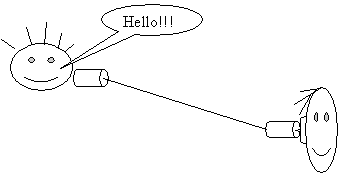 37.
Telephone
37.
Telephone
When you are discussing different wave types it is good to let the pupils
make there own “plastic telephone”. Ask them how it works and when there are
best conditions for it to work. You just need two plastic cups and a string.
Physics: Waves
38. Traveling
fluids
Take two glasses with flat edges and a piece of
carton. Fill one glass, till the edge, with colored cold water. Put on top of
the glass the piece of carton. Fill the other glass with warm water, also
colored but in a different color. Put the glass filled, with cold water upside
down on the glass filled with warm water. The warm water will go up and the cold
water will come down.
Physics: convex ion
39.
The magic playing cards
Lay
five playing cards on the table. Put your thumb on the first and push very hard.
When you take your hand of the table the card will be there at your thumb. Put
this card exactly on the following card end push again very hard. Now the two
cards will stay at your thumb. Do the same with the other cards.
Physics:
air pressure
40.
Falling student.
Take
two empty cans, which are not damaged. Let a student stand on the empty cans.
Now give a smash into one of the cans. The can will collapse.
Physics:
structures, forces
41.
The bouncing
glass tube
Take
a glass tube with a very round side. Let it fall on the hard ground, so that the
round side hits the ground. After it bounced pick it up, otherwise it will
crash.
Physics:
materials, elastics.
42.
Flying balloons
Blow up a balloon and let it fly. It’s path will be random. Now put a straw in the balloon and blow it up again. You will see that the balloon will fly in a straight line.
Physics:
third Newton law
43.
Camera Obscura
Take
a toilet paper roll and cover one end with transparency paper and the other end
with just a normal piece of paper. Put a small hole in the last one. Point the
hole at a flame of a candle and at the transparency paper you will see the flame
up side down.
Physics:
optics
44.
Car detection
Make
a coil out of a cupper wire and connect it to an oscilloscope. Then pass this
coil with an (5 kg) iron ball. The oscilloscope will detect the change of the
magnetic field.
45.
Weightless
Take
a bottle and make a hole down at the side. Fill the bottle with water. If you
let the water flow out of it, you will see a parabolic curve. Go standing on a
chair and let the bottle fall, there will be no water flowing out of the bottle.
Physics:
Weightless
46.
Communicating balloons
Cut
the bottom out of the bottle. Put a membrane on the bottom and one on the top.
Pull at the membrane at the bottom and the balloon at the top will shrink. Push
at the membrane at the bottom and the balloon at the top will grow.
47.
Moving Walls

Breaking
eggs:
![]() exp26.rm
exp26.rm
Falling bottle of water:
![]() exp11.rm
exp11.rm
